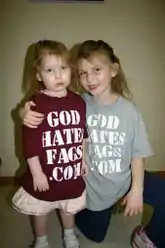Gang
A gang, in the popular usage, is a group of people formed around a common identity. Members of these gangs usually assume an adversarial stance towards society, or at least some other group. More generally, the term used to refer to any group such as a work gang, now uncommon since the term has assumed negative connotations. The usage today is often in the context of moral panics about crime, drugs, "outlaw" gangs, and kids wearing baggy pants and their hats backwards at the mall.

| The high school yearbook of society Sociology |
| Memorable cliques |
| Class projects |
|
v - t - e |
The general consensus for the definition of a gang is that:[1]
- It has three or more members, generally aged 12-24.
- Members share an identity, typically linked to a name, and often other symbols.
- Members view themselves as a gang, and they are recognized by others as a gang.
- The group has some permanence and a degree of organization.
- The group is involved in an elevated level of criminal activity.
Gang culture
| This section requires more sources. |
Gang culture is a term used mostly by the media when referring to rising levels of violence and urban crime. Although the criminals may not be part of formal gangs, the term is a catch-all one and often cited as a "cause" of increased violent crime, often used synonymously with terms such as "gun culture" or "knife culture" in reference to the rising incidences of these weapons being used. Blame is often placed on rap music, dance music, heavy metal or any other form of music that middle-aged, right-wing newspaper columnists don't understand. The music is usually imported from America, although the trans-Atlantic crossing has worked the other way at times. Inner-city gangs tend to have exceptionally macho names like "The Burger Bar Boys" or "The East Side Playpark Massiiiifffff".
Gang banger is an American term used in connection with gang culture — the use of which causes no end of amusement among the British.[note 1]
Purported gangs
- Lesbians
- Outlaw or "1%er" motorcycle clubs, though four major clubs have been designated as actual criminal gangs: the Hells Angels, the Pagans, the Outlaws, and the Bandidos[2][3]
- Kids wearing baggy pants and their hats backwards at the mall
Occupy Wall StreetWall Street[1]- Straight edge, at least according to the Salt Lake City police[4]
- Westboro Baptist Church[5]
Actual gangs
- The Manson Family
- The Church of Scientology
- The National Socialist German Workers' Party (NSDAP) (defunct)
- Rochdale sex trafficking gang
- Urban street gangs: Crips,
File:Wikipedia's W.svg Bloods,File:Wikipedia's W.svg etc. - Various gangs involved in organized crime, such as La Familia Michoacana
Notes
- Don't try to look this up at work, unless you work in a brothel or the Netherlands.
References
- Is Wall Street a gang? by Randall Shelden (October 25, 2011) Center on Juvenile and Criminal Justice.
- Safe Street Violent Crime Initiative Report (2000) FBI
- 2004 Annual Report, Organized Crime in Canada (2004) Criminal Intelligence Service Canada
- The Twisted World of a 'Straight Edge' Gang by Louis Sahagun (January 29, 1998) Los Angeles Times.
- The Greatest Gang Fight Ever Featured The KKK, BLM, The Westboro Baptist Church And Urine by Jordie (7/20/2016 11:10 AM) Barstool Sports.